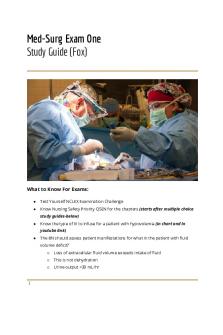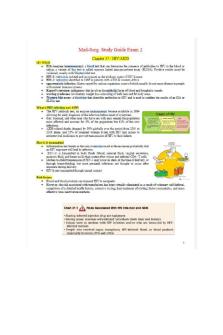Med surg exam 3 study guide PDF

| Title | Med surg exam 3 study guide |
|---|---|
| Course | NURSING OF ADULTS |
| Institution | The University of Texas at Arlington |
| Pages | 68 |
| File Size | 2.1 MB |
| File Type | |
| Total Downloads | 7 |
| Total Views | 38 |
Summary
Gender Specific – Chapters 57, 58, and 59Pelvic Inflammatory Disease: inflammatory condition of the pelvic cavity that may begin with cervicitis and involve the uterus (endometritis), fallopian tubes (salpingitis), ovaries (oophoritis), pelvic peritoneum, or pelvic vascular system.Clinical Manifesta...
Description
Gender Specific – Chapters 57, 58, and 59 Pelvic Inflammatory Disease: inflammatory condition of the pelvic cavity that may begin with cervicitis and involve the uterus (endometritis), fallopian tubes (salpingitis), ovaries (oophoritis), pelvic peritoneum, or pelvic vascular system. Clinical Manifestations: vaginal discharge, dyspareunia (painful intercourse), dysuria, pelvic or lower abdominal pain, tenderness that occurs after menses & postcoital bleeding Others include: fever general malaise, anorexia, N/V, headache
Potential Complications: ● Pelvic or generalized peritonitis ● Abscesses ● Strictures ● fallopian tube obstruction - could lead to ectopic pregnancy which could lead to sterility ● Adhesions could lead to chronic pelvic pain that might indicate the removal of the uterus, fallopian tubes and ovaries Medical Management: Broad-spectrum antibiotics (Rocephin, doxycycline, flagyl) Usually occurs as an outpatient & monitored closely
Nursing Management: What does the nurse need to assess for? Assess for both physical and emotional effects of PID, pt. may feel well one day and experience vague symptoms and discomfort the next, record vitals, I&Os, and the characteristics and amount of vaginal discharge Pain management? Analgesics, promote rest and healthy diet, try to minimize infection What is important to cover in the home care instructions? Knowledge of the medications, importance of health practices (prevent infection), knowing the signs of ectopic pregnancy (pain, abnormal bleeding, delayed menses, faintness, dizziness and shoulder pain), how to prevent recurrence and when to see the provider (pelvic pain or abnormal discharge after intercourse, childbirth or pelvic surgery, unusual vaginal discharge or odor Endometriosis
Any risk factors? Family history, having no children or pregnancy at a late age, increased use of laparoscopy, shorter menstrual cycle, flow longer than 7 day, younger menarche, outflow obstruction Clinical Manifestations: Dysmenorrhea, dyspareunia, pelvic pain/discomfort, dyschezia and pain radiating down the back or leg, infertility What is the usual Medical Management? Routine exam (for those with no symptoms), NSAIDs, oral contraceptive agents, GnRH agents, or surgery. Pregnancy can alleviate symptoms, because neither ovulation nor menstruation occur. Nursing management: Assess pelvic pain, reduce anxiety, effects of meds, women’s reproductive plans, educate about alternative reproductive technology or adoption Hysterectomy What is taken out? Uterus to treat cancer, dysfunctional uterine bleeding, endometriosis, nonmalignant growths, persistent pain, pelvic relaxation & prolapse and previous injury to the uterus Preoperative Management: pregnancy needs to be ruled out, prophylactic antibiotics prior to surgery and need to be discontinued the next day Are there medications to avoid? Anticoagulants, NSAIDs (aspirin), vitamin E = these could increase bleeding Postoperative Management: Risk for infection, hemorrhage, voiding problems, edema or nerve trauma → temporary loss of bladder tone (bladder atony) might need catheter, VTE
NURSING PROCESS- The Patient Undergoing a Hysterectomy ● Anxiety related to the diagnosis of cancer, fear of pain, possible perception of loss of femininity or childbearing potential ○ Interventions: verbalize pt. Concerns, explain preparations/procedure, educate the pt. about the outcomes of surgery, feelings of loss and managing symptoms, treatment options, info & support groups ● Disturbed body image related to altered fertility and fears about sexuality and relationships with partner and family ○ Interventions: reassurance about sexual relationships, function and satisfaction, answer questions, inform them about hormonal balance may feel depressed or heightened emotional sensitivity to people and situations
○ Evaluation: discusses changes resulting from surgery with her partner, verbalizes understanding of her disorder and the treatment plan, displays minimal depression or anxiety ● Acute pain related to surgery and other adjuvant therapy ○ Interventions: assess intensity of the pt. Pain and assist with analgesics, if the pt. Has abdominal distension or flatus, a rectal tube and application of heat to the abdomen may be prescribed. Fluids and soft diet if permitted and early ambulation ○ Evaluation: reports relief of abdominal pain and discomfort and ambulates without pain ● Deficient knowledge of the perioperative aspects of hysterectomy and postoperative self-care ○ Interventions: practices deep-breathing, turning, and leg exercises as instructed, increases activity and ambulation daily, reports adequate fluid intake and adequate urinary output, identifies reportable symptoms, schedules and keeps follow-up appointments ○ Absence of complications with minimal vaginal bleeding and normal vitals, ambulates early, no chest or calf pain and reports no urinary problems or abdominal distension
Chapter 58 Fibroadenomas are firm, round, movable, benign tumors. They can occur from puberty to menopause with a peak incidence at 30 years of age. TABLE 58-2 Comparison of Various Breast Masses (Know the differences)
MALIGNANT CONDITIONS OF THE BREAST Types: beware of the difference – not too much detail. beware they exist, which is better to get? ● Ductal Carcinoma in Situ (better to have) Characterized by proliferation of malignant cells inside the milk ducts without invasion of the surrounding tissue BUT this can turn into invasive breast cancer ● Invasive Cancer Over 7 other types, infiltrating ductal carcinoma is the most histologic type of breast cancer (80% of cases) the tumors arise from the duct system and invade the surrounding tissues and often form solid irregular mass. Another type of invasive cancer is Paget Disease that causes scaly, erythematous, pruritic lesions of the nipple. TABLE 58-3 Risk Factors for Breast Cancer (Summarizes risk factors) Female gender, increasing age, personal and family history of breast cancer, genetic mutation, hormonal factors (early/late menarche, late age pregnancy, hormone therapy), exposure to ionizing radiation, history of benign proliferative breast disease, obesity, high-fat diet, alcohol intake Chart 58-3 Pathologic Factors Associated with Favorable Prognosis for Breast Cancer
Surgical Management: breast conservation or total mastectomy
NURSING PROCESS- The Patient Undergoing Surgery for Breast Cancer Pre Op nursing concerns: ● Deficient knowledge about the planned surgical treatments ○ Interventions: review treatment options by reinforcing information provided to the pt. and answer questions, pt. needs to informed that they will go home with drains (drain care info), also inform that they will have decreased arm and shoulder mobility after and they need to do ROM exercises
○ Evaluation: asks relevant questions about diagnosis and available surgical treatments, states rationale, describes advantages and disadvantages of treatment options ● Anxiety related to the diagnosis of cancer & Fear related to specific treatments and body image changes & Risk for defensive or ineffective coping related to the diagnosis of breast cancer and related treatment options ○ Interventions: provide realistic expectations about the healing process and expected recovery helps alleviate fear, provide info about support groups and available resources ○ Evaluation: verbalizes feelings appropriately and recognizes normalcy of mood lability, discusses impact of diagnosis and treatment on family and work ● Decisional conflict related to treatment options ○ Interventions: make sure that the pt. understands their treatment options, ask questions that help the pt. focus on their decision in a supportive way Post op nursing concerns: ● Acute pain and discomfort related to surgical procedure ○ Interventions: analgesic medication can provide relief, alternative methods of pain management like taking warm showers (if permitted) and using distraction methods (like guided imagery) ○ Evaluation: reports pain has decreased and states pain and discomfort management strategies are effective ● Peripheral neurovascular dysfunction related to nerve irritation in affected arm, breast, or chest wall ○ Interventions: assess the pt. Readiness and provide gentle encouragement, acknowledge pt. Feelings and reassure ○ Evaluation: identifies postop sensations and recognizes that they are a normal part of the healing process ● Disturbed body image related to loss or alteration of the breast & Risk for ineffective coping related to the diagnosis of cancer and surgical treatment & Self-care deficit related to partial immobility of upper extremity on operative side ○ Interventions: identify and mobilize support systems, provide guidance, support and education to them, discuss issues or concerns, provide information about plan of care and refer her to support groups, referrals to mental health providers if ineffective coping ○ Evaluation: participates in self-care measures, discusses meaning of the diagnosis, surgical treatment and fears appropriately ● Risk for sexual dysfunction related to loss of body part, change in self-image, and fear of partner’s responses
○ Interventions: encourage discussing feelings, clarify issues, provide referrals to counseling ○ Evaluation: discusses issues of sexuality and resumption of sexual activity ● Deficient knowledge: drain management after breast surgery, arm exercises to regain mobility of affected extremity, hand and arm care after ALND ○ Interventions: Monitor for lymphedema (swelling of an extremity from interrupted lymphatic circulation), hematoma or seroma formations (collection of blood or serous fluid in cavity) under breast incision after mastectomy or breast conservation or in axilla ○ Evaluation: demonstrates appropriate care of incisions and drainage system, arm exercises, identifies s&s of infections and complications
Chart 58-5 Hand and Arm Care After Axillary Lymph Node Dissection – important
58-7 Exercise After Breast Surgery – important Wall hand climbing, rope turning, rod or broomstick lifting, and pulley tugging Adjuvant Hormonal Therapy Used to Treat Breast Cancer When is it used? With or without chemotherapy, in women with hormone receptor-positive tumors What are the side effects? Hot flashes, vaginal dryness, N/V, MS pain, risk for VTE, endometrial cancer, osteoporosis and fractures Reconstructive Procedures After Mastectomy: mammoplasty
Chapter 59 BPH Benign Prostatic Hyperplasia (Enlarged Prostate)
Risk factors: smoking, alcohol, obesity, reduced activity level, HTN, CV disease, diabetes, western diet (high in animal fat and proteins, refined carbs and low in fiber) Clinical manifestations: obstructive and irritative symptoms include urinary frequency, urgency, nocturia, hesitancy in starting urination, decreased and intermittent force of stream and the sensation of incomplete bladder emptying, abdominal straining with urination, a decrease in the volume and force of the urinary system, dribbling and complications of the acute urinary retention and recurrent UTIs What is the medical management? If pt. Is unable to void catheter is placed, a metal catheter may be placed with prostatic curve may be used if obstruction is severe OR a cystostomy (incision into the bladder) for urinary drainage What medications might be used? ● Alpha-adrenergic blockers: doxazosin (cardura) or tamsulosin (flomax) ● 5-alpha-reductase inhibitors: finasteride (Proscar) or dutasteride (Avodart) TURP-What is it? Transurethral resection of the prostate, removal of inner portion of prostate through endoscopy inserted through the urethra What does the nurse needs to monitor? ● Monitor for hemorrhage (most common complication)and symptoms of urethral stricture (dysuria, straining, weak urinary system) ● CBI (murphy drip), monitor drainage, maintain catheter patency, bladder spasms, control pain and avoid straining with BM ○ MURPHY DRIP: is a bladder 3-way drainage system that uses gravity to help prevent clots and allows for continuous irrigation with TURP. This prevents hemorrhaging from the overdistension of the bladder ■ The amount of fluid recovered in the drainage bag MUST EQUAL the amount instilled ■ An occlusion of the system might present as the pt. urge to void and bladder spasm
Cancer of the Prostate Any risk factors? African American, increasing age, family history, diet high in red meat or dairy that is high in fat, endogenous hormones What are the clinical manifestations? ● Symptoms of urinary obstruction- difficulty and frequency of urination, urinary retention, and decreased size and force of the urinary system ● Others include blood/semen in urine, painful ejaculation How is it diagnosed? DRE, serum PSA and ultrasound-guided TRUS w/biopsy Medical management: Therapeutic vaccines kill existing cancer cells and provide long-lasting immunity against further development like sipuleucel-T (Provenge) & other medications Surgery: prostatectomy Radiation therapy: teletherapy (external) and/or brachytherapy (internal)
Chart 59-3 The Patient with Prostate Cancer- important ● Anxiety related to concern and lack of knowledge about the diagnosis, treatment plan, and prognosis, urinary difficulties and treatment modalities ● Urinary retention related to urethral obstruction secondary to prostatic enlargement or tumor and loss of bladder tone due to prolonged distention/retention ● Imbalanced nutrition: less than then body requirements related to decreased oral intake because anorexia, N/V caused by cancer or its treatment ● Sexual dysfunction related to effects of therapy (chemo, hormonal, radiation therapy, surgery)
● Impaired physical mobility related to tissue hypoxia, malnutrition and exhaustion and to spinal cord or nerve compression from metastases ● Hemorrhage, infection, bladder neck obstruction TABLE 59-4 Surgical Approaches for Treatment of Prostate Disorders- great summary ☺ Transurethral resection (TURP), open surgical removal (suprapubic/perineal/retropubic approach), Transurethral incision (TUIP), laparoscopic radical prostatectomy NURSING PROCESS- Patient Undergoing Prostatectomy PREOPERATIVE NURSING DIAGNOSES ● Anxiety about surgery and its outcome- encourage verbalizing feelings and concerns ● Acute pain related to bladder distention- monitor voiding patterns, watch for distension, and assist with catheterization ● Deficient knowledge about factors related to the disorder and the treatment protocol POSTOPERATIVE NURSING DIAGNOSES ● Risk for imbalanced fluid volume- monitor I&Os, including amount of fluid used for irrigation to make sure the irrigation fluid is not being retained, monitor for electrolyte imbalances, inc. BP, confusion and respiratory distress ● Acute pain related to the surgical incision, catheter placement, and bladder spasmsencourage ambulation, assess pain (may be incisional pain, if it is in the flank area may be kidney problem or caused from bladder spasms, monitor drainage tubing ● Deficient knowledge about postoperative care COLLABORATIVE PROBLEMS/POTENTIAL COMPLICATIONS ● Hemorrhage and shock ○ Avoid aspirin, NSAIDs, platelet inhibitors 10-14 days before surgery ○ Bleeding may result in clot formation which could obstruct urine flow, drainage begins as reddish-pink then to light pink in 24 hr ● Infection ○ Careful aseptic technique for dressing changes, contact provider for S&S of infection ○ UTIs and epididymitis common complications after, may need antibiotics ● Venous thromboembolism (VTE)- early ambulation, turning ● Catheter obstruction ○ lasix promotes to initiate post op diuresis, keep catheter patent, watch for bladder distension ● Complications with catheter removal ● Urinary incontinence ○ Increasing voiding frequency, decreasing fluid intake prior to activities, pelvic floor exercises ● Sexual dysfunction
Discharge instructions: routine health screening and health promotion activities, education how to manage drainage system, assess for complications and promote recovery
Chapter 36: HIV Infection and AIDS Worksheet
Pay close attention to stage 3 – opportunistic infection
Stages of HIV Infection There are five stages of HIV infection: Stage 0 Primary infection or acute HIV infection (previously known as the window period) Period during which those who are HIV positive test negative on the HIV antibody blood test, although they are infected and highly infectious, because their viral loads are very high. What kind of symptoms might the nurse see? Fever, fatigue, or rash Stage 1 HIV-1 is firmly established in the host Can this last years? Yes Is the patient symptomatic? Stage 2 Occurs when CD4+ T-lymphocyte cells are between 200 and 499 Stage3 When the count drops below 200 cells/mm3 of blood and at this point, the person is considered to have AIDS for surveillance purposes.
HIV Transmission How is it transported? In body fluids (blood, seminal fluid, vaginal secretions, amniotic fluid, and breast milk) that contain infected cells. Who is at risk to develop? Chart 36-2
Prevention of HIV Infection How does the nurse help in the prevention of HIV infection? How does the nurse educate on how to eliminate or reduce risk factors? Encourage use of condoms - highly effective Could there be barriers to this practice? What could the nurse discuss with the partners if they do not want to use condoms? Pre-exposure prophylaxis (Prep) - taken daily. Check HIV status q 3 months
Preventive Education (36-3 and 36-4)
How can we Reduce the Risk of Transmission to Health Care Providers Standard Precautions - Chart 36-5
Post-exposure prophylaxis (PEP) includes taking antiretroviral medicines as soon as possible, but no more than 72 hours (3 days) after possible HIV exposure; two to three drugs are usually prescribed which must be taken for 28 days.
What else must occur? (chart 36-6)
HIV Tests Why are Several screening tests used to diagnose HIV infection? STARHS analyzes HIV-positive blood samples to determine whether an HIV infection is recent or has been ongoing Three types of HIV diagnostic tests: Antibody tests - detect antibodies, not HIV itself Antigen/antibody tests & Nucleic acid (RNA) tests directly tests HIV Who should be routine screened? All persons aged 15 to 65 years, as well as screening for younger or older persons who are at risk What Follow-up testing is performed if the initial test result is positive to ensure a correct diagnosis. ● Antibody differentiation tests, which distinguishes HIV-1 from antibodies ● HIV-1 nucleic acid tests, which looks for the virus RNA directly Table 36-3 identifies common blood tests used for screening.
Are there any other screening tests that should be done? What is the key goal of ART? Suppress HIV replication to a level below which drug-resistant mutations do not emerge
Treatment of HIV Infection What lab is the major indicator of immune function and prophylaxis for opportunistic infections, and is the strongest predictor of subsequent disease progression and survival? CD4 count Who should be on antiretroviral therapy (ART)? All HIV-infected patients regardless of their viral load or CD4+ count To achieve viral suppression – how many medications need to be used? Viral suppression requires the use of ART with at least two, and preferably three, active drugs from two or more drug classes and should occur within the first 12 to 24 weeks of therapy especially if the patient is new to ART Chart 36-8 summarizes strategies that health care providers can encourage to promote treatment regimen adherence. How can a nurse know the ART is effective? Laboratory tests evaluate whether ART is effective for a specific patient. An adequate CD4+ response for most patients on ART is an increase in CD4+ count in the range of 50 to 150 3
mm per year, generally with an accelerated response in the first 3 months. Viral load should be measured at baseline and on a regular basis thereafter because viral load is the most important indicator of response to ART. What are some Adverse effects associated with all HIV treatment regimens? H...
Similar Free PDFs

Med surg exam 3 study guide
- 68 Pages

Med Surg 2 Exam 3 Study Guide
- 22 Pages

Med Surg Exam 3
- 19 Pages
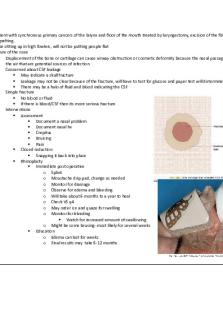
Med Surg II - Exam 2 Study Guide
- 57 Pages

Med surg exam 1 study guide
- 25 Pages
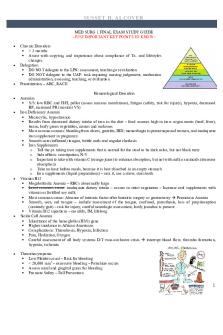
MED SURG 1 Final EXAM Study Guide
- 10 Pages
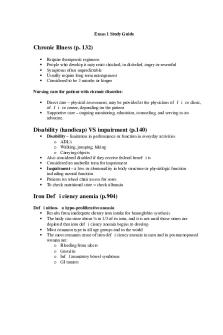
Exam 1 Study Guide - Med-Surg
- 26 Pages

Med Surg Study guide Notes
- 66 Pages

MED SURG EXAM 3-2
- 54 Pages

Med Surg 2 Final Study Guide
- 25 Pages
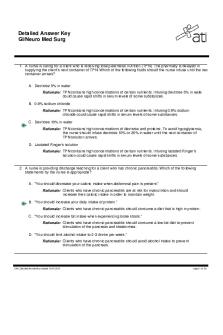
Ati gi med surg - Gi study guide
- 53 Pages
Popular Institutions
- Tinajero National High School - Annex
- Politeknik Caltex Riau
- Yokohama City University
- SGT University
- University of Al-Qadisiyah
- Divine Word College of Vigan
- Techniek College Rotterdam
- Universidade de Santiago
- Universiti Teknologi MARA Cawangan Johor Kampus Pasir Gudang
- Poltekkes Kemenkes Yogyakarta
- Baguio City National High School
- Colegio san marcos
- preparatoria uno
- Centro de Bachillerato Tecnológico Industrial y de Servicios No. 107
- Dalian Maritime University
- Quang Trung Secondary School
- Colegio Tecnológico en Informática
- Corporación Regional de Educación Superior
- Grupo CEDVA
- Dar Al Uloom University
- Centro de Estudios Preuniversitarios de la Universidad Nacional de Ingeniería
- 上智大学
- Aakash International School, Nuna Majara
- San Felipe Neri Catholic School
- Kang Chiao International School - New Taipei City
- Misamis Occidental National High School
- Institución Educativa Escuela Normal Juan Ladrilleros
- Kolehiyo ng Pantukan
- Batanes State College
- Instituto Continental
- Sekolah Menengah Kejuruan Kesehatan Kaltara (Tarakan)
- Colegio de La Inmaculada Concepcion - Cebu


